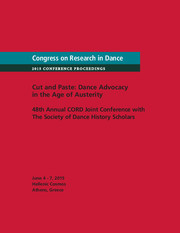No CrossRef data available.
Article contents
Sacred Sound: Tuning the Cosmic Strings of the Subtle Dancing Body
Published online by Cambridge University Press: 05 December 2013
Abstract
A. K. Coomaraswamy writes in The Dance of Shiva that Nataraja, the Hindu dancing figure, is the “clearest image of the activity of God which any art or religion can boast of.” Nataraja's dance activates dormant vital energy (kundalini) and resonates with the primordial sacred seed sounds (bijas) of the cosmos. Sanskrit seed sounds such as Aum are described in the Katha Upanishads as “consciousness or God (Brahman) itself.” In his book, Healing Mantras, Ashley-Farrand writes that the practice of mantra brings about positive changes in matter and consciousness by the agency of a subtle vibration. Cyndi Dale in The Subtle Body correlates each note of the ancient Solfeggio scale used in Gregorian chants to the energy centers (chakras) in the body. Sacred sounds are recited in Buddhist chants, Jewish hymns (Zemirot), and the dances of Sufi whirling dervishes, among other traditions. The dancer, through mastery of breath, form, and heightened awareness of sound, possesses the potential to “ride” on the crests of musical waves of sacred sound and harmoniously vibrate with wavelike patterns of energy or “cosmic strings,” identified in quantum physics as the essence of matter, and thereby facilitate healing and self-integration. However, in mainstream dance practice and research, sound/movement spiritual practices are largely relegated to the separate category of “new age,” dance therapy, or yoga. This performative paper discusses how the integration of the mindful use of sacred sound in contemporary dance training has profound implications for expanding consciousness, heightening creativity, and enhancing physical capabilities.
- Type
- Research Article
- Information
- Copyright
- Copyright © Andrea Mantell Seidel 2012


